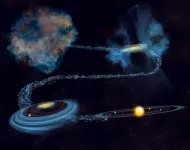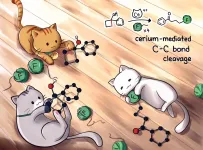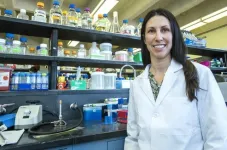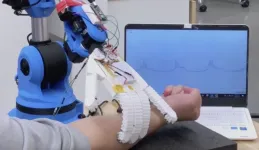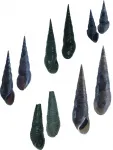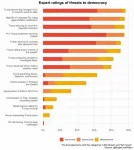INFORMATION:
This work was supported in part by JINA-CEE a U.S. National Science Foundation (NSF) Physics Frontiers Center operating under grant No. PHY- 1430152, and by IReNA, an NSF AccelNet Network of Networks operating under grant OISE-1927130.
Meteorites remember conditions of stellar explosions
Radioactivity in meteorites sheds light on origin of heaviest elements in our solar system
2021-02-26
(Press-News.org) A team of international researchers went back to the formation of the solar system 4.6 billion years ago to gain new insights into the cosmic origin of the heaviest elements on the period-ic table.
Led by scientists who collaborate as part of the International Research Network for Nuclear Astrophysics (IReNA) (irenaweb.org) and the Joint Institute for Nuclear Astrophysics - Center for the Evolution of the Elements (JINA-CEE) (jinaweb.org), the study is published in the lat-est issue of the journal Science (science.sciencemag.org/content/371/6532/945).
Heavy elements we encounter in our everyday life, like iron and silver, did not exist at the beginning of the universe, 13.7 billion years ago. They were created in time through nuclear reactions called nucleosynthesis that combined atoms together. In particular, iodine, gold, platinum, uranium, plutonium, and curium, some of the heaviest elements, were created by a specific type of nucleosynthesis called the rapid neutron capture process, or r process.
The question of which astronomical events can produce the heaviest elements has been a mystery for decades. Today, it is thought that the r process can occur during violent collisions between two neutron stars, between a neutron star and a black hole, or during rare explosions following the death of massive stars. Such highly energetic events occur very rarely in the universe. When they do, neutrons are incorporated in the nucleus of atoms, then converted into protons. Since elements in the periodic table are defined by the number of protons in their nucleus, the r process builds up heavier nuclei as more neutrons are captured.
Some of the nuclei produced by the r process are radioactive and take millions of years to decay into stable nuclei. Iodine-129 and curium-247 are two of such nuclei that were pro-duced before the formation of the sun. They were incorporated into solids that eventually fell on the earth's surface as meteorites. Inside these meteorites, the radioactive decay generat-ed an excess of stable nuclei. Today, this excess can be measured in laboratories in order to figure out the amount of iodine-129 and curium-247 that were present in the solar system just before its formation.
Why are these two r-process nuclei are so special? They have a peculiar property in com-mon: they decay at almost exactly the same rate. In other words, the ratio between iodine-129 and curium-247 has not changed since their creation, billions of years ago.
"This is an amazing coincidence, particularly given that these nuclei are two of only five ra-dioactive r-process nuclei that can be measured in meteorites," says Benoit Co?te? from the Konkoly Observatory, the leader of the study. "With the iodine-129 to curium-247 ratio being frozen in time, like a prehistoric fossil, we can have a direct look into the last wave of heavy element production that built up the composition of the solar system, and everything within it."
Iodine, with its 53 protons, is more easily created than curium with its 96 protons. This is because it takes more neutron capture reactions to reach curium's higher number of protons. As a consequence, the iodine-129 to curium-247 ratio highly depends on the amount of neutrons that were available during their creation.
The team calculated the iodine-129 to curium-247 ratios synthesized by collisions between neutron stars and black holes to find the right set of conditions that reproduce the composition of meteorites. They concluded that the amount of neutrons available during the last r-process event before the birth of the solar system could not be too high. Otherwise, too much curium would have been created relative to iodine. This implies that very neutron-rich sources, such as the matter ripped off the surface of a neutron star during a collision, likely did not play an important role.
So what created these r-process nuclei? While the researchers could provide new and insightful information regarding how they were made, they could not pin down the nature of the astronomical object that created them. This is because nucleosynthesis models are based on uncertain nuclear properties, and it is still unclear how to link neutron availability to specific astronomical objects such as massive star explosions and colliding neutron stars.
"But the ability of the iodine-129 to curium-247 ratio to peer more directly into the fundamental nature of heavy element nucleosynthesis is an exciting prospect for the future," said Nicole Vassh from the University of Notre Dame, coauthor of the study.
With this new diagnostic tool, advances in the fidelity of astrophysical simulations and in the understanding of nuclear properties could reveal which astronomical objects created the heaviest elements of the solar system.
"Studies like this are only possible when you bring together a multidisciplinary team, where each collaborator contributes to a distinct piece of the puzzle. The JINA-CEE 2019 Frontiers meeting provided the ideal environment to formalize the collaboration that led to the current result," Côté said.
ELSE PRESS RELEASES FROM THIS DATE:
Cerium sidelines silver to make drug precursor
2021-02-26
HOUSTON - (Feb. 26, 2021) - Save your silver! It's better used for jewelry than as a catalyst for drugs.
Rice University scientists have developed a greatly simplified method to make fluoroketones, precursors for drug design and manufacture that typically require a silver catalyst.
Rice chemist Julian West and graduate students Yen-Chu Lu and Helen Jordan introduced a process for the rapid and scalable synthesis of fluoroketones that have until now been challenging and expensive to make.
Their open-access work graces the cover of the Feb. 21 issue of the Royal Society of ...
Researchers identify characteristics of highest utilizers for mental health hospital services
2021-02-26
Dropping out of high school, having schizophrenia, or being diagnosed with a co-occurring personality disorder increases the likelihood of someone becoming a "high utilizer" of inpatient psychiatric hospital services, according to a new study by researchers at The University of Texas Health Science Center at Houston (UTHealth). A high utilizer is someone who has been admitted three or more times within one year.
The research was published today in The Journal of Health Care for the Poor and Underserved.
For their findings, researchers used machine learning to analyze deidentified electronic ...
Research reveals how bacteria defeat drugs that fight cystic fibrosis
2021-02-26
MISSOULA - University of Montana researchers and their partners have discovered a slimy strategy used by bacteria to defeat antibiotics and other drugs used to combat infections afflicting people with cystic fibrosis. The research was published Feb. 23 in the journal Cell Reports.
Cystic fibrosis is a life-threatening disease that causes persistent lung infections and limits a person's ability to breathe over time. A common strain of bacteria, Pseudomonas aeruginosa, often thrives in the lungs of people with cystic fibrosis, as well as in wounds from burns or diabetic ulcers. Once a P. aeruginosa infection is established, ...
Sensing robot healthcare helpers being developed at SFU
2021-02-26
Robots that could take on basic healthcare tasks to support the work of doctors and nurses may be the way of the future. Who knows, maybe a medical robot can prescribe your medicine someday? That's the idea behind 3D structural-sensing robots being developed and tested at Simon Fraser University by Woo Soo Kim, associate professor in the School of Mechatronic Systems Engineering.
"The recent pandemic demonstrates the need to minimize human-to-human interaction between healthcare workers and patients," says Kim, who authored two recent papers on the subject - a perspective on the technology and a demonstration of a robots' usefulness in healthcare. "There's an opportunity for sensing robots to measure ...
Agents of food-borne zoonoses confirmed to parasitise newly-recorded in Thailand snails
2021-02-26
Parasitic flatworms known as agents of food-borne zoonoses were confirmed to use several species of thiarid snails, commonly found in freshwater and brackish environments in southeast Asia, as their first intermediate host. These parasites can cause severe ocular infections in humans who consume raw or improperly cooked fish that have fed on infected snails. The study, conducted in South Thailand by Thai and German researchers and led by Kitja Apiraksena, Silpakorn University, is published in the peer-reviewed open-access journal Zoosystematics and Evolution.
"Trematode infections are major public health problems affecting humans in southeast Asia," explain the scientists. "Trematode infections depend not only on the habit of people, but also on the presence of first ...
New tools find COVID patients at highest risk of mechanical ventilation and death
2021-02-26
BOSTON - Two novel calculators for predicting which patients admitted to the hospital with COVID-19 are at greatest risk of requiring mechanical ventilation or of in-hospital death have been developed and validated by Massachusetts General Hospital (MGH). In a study published in The Lancet's EClinicalMedicine, researchers describe how these models could enable clinicians to better stratify risk in COVID-infected patients to optimize care and resource utilization in hospitals faced with ICU capacity constraints.
"Information that can accurately predict severity of the clinical course at the time of hospital admission has been limited," says senior author Rajeev Malhotra, MD, a cardiologist at MGH and investigator in the MGH Cardiovascular Research Center. ...
Exposure to diverse career paths can help fill labor market 'skills gap'
2021-02-26
COLUMBIA, Mo. -- When Patrick Rottinghaus began college, he had no idea what he wanted to do with his career. He started out as an "Open" major while he explored possibilities.
Today, Rottinghaus, an associate professor in the University of Missouri College of Education, is helping young people eager to find their place in the world by identifying their strengths and connecting them with careers that match their skillset, interests and personality. As the father of three children, including a daughter soon to enter high school, he wants to ensure they are equipped ...
Engineering the boundary between 2D and 3D materials
2021-02-26
In recent years, engineers have found ways to modify the properties of some "two- dimensional" materials, which are just one or a few atoms thick, by stacking two layers together and rotating one slightly in relation to the other. This creates what are known as moiré patterns, where tiny shifts in the alignment of atoms between the two sheets create larger-scale patterns. It also changes the way electrons move through the material, in potentially useful ways.
But for practical applications, such two-dimensional materials must at some point connect with the ordinary world of 3D materials. An international team led by MIT researchers has now come up with a way of imaging what goes on at these ...
Republican and Democratic voters agree on one thing--the need for generous COVID-19 relief
2021-02-26
Both Democrats and Republicans overwhelmingly favor politicians who support generous COVID-19 relief spending, yet remain deeply polarized over the legitimacy of the 2020 presidential election results and former President Donald Trump's second impeachment. Meanwhile, political experts find that the former president's actions and those taken by congressional supporters in the aftermath of the election represent serious departures from American democratic norms.
Those are among the most recent findings of Bright Line Watch, the political science research project cofounded by Gretchen Helmke, a professor of political science at the ...
New study highlights importance of context to physical theories
2021-02-26
A Swansea University scientist's research into the geometrical characteristics of a physical theories is highlighted in a new paper.
Physicist Dr Farid Shahandeh said: "Imagine a physical theory whose explanation for the trajectory of an apple falling from a tree differs for Gala and Pink Lady. We know that the apple's variety has nothing to do with how it falls. A theory like this is overcomplicated.
"Any seemingly unnecessary and nonsensical parameter like this adds context to a theory's description of a physical phenomenon.
"Luckily, classical theories are not contextuality. But, we know that if we try to interpret quantum mechanics in classical terms, it becomes contextual, and consequently ...
LAST 30 PRESS RELEASES:
First Editorial of 2026: Resisting AI slop
Joint ground- and space-based observations reveal Saturn-mass rogue planet
Inheritable genetic variant offers protection against blood cancer risk and progression
Pigs settled Pacific islands alongside early human voyagers
A Coral reef’s daily pulse reshapes microbes in surrounding waters
EAST Tokamak experiments exceed plasma density limit, offering new approach to fusion ignition
Groundbreaking discovery reveals Africa’s oldest cremation pyre and complex ritual practices
First breathing ‘lung-on-chip’ developed using genetically identical cells
How people moved pigs across the Pacific
Interaction of climate change and human activity and its impact on plant diversity in Qinghai-Tibet plateau
From addressing uncertainty to national strategy: an interpretation of Professor Lim Siong Guan’s views
Clinical trials on AI language model use in digestive healthcare
Scientists improve robotic visual–inertial trajectory localization accuracy using cross-modal interaction and selection techniques
Correlation between cancer cachexia and immune-related adverse events in HCC
Human adipose tissue: a new source for functional organoids
Metro lines double as freight highways during off-peak hours, Beijing study shows
Biomedical functions and applications of nanomaterials in tumor diagnosis and treatment: perspectives from ophthalmic oncology
3D imaging unveils how passivation improves perovskite solar cell performance
Enriching framework Al sites in 8-membered rings of Cu-SSZ-39 zeolite to enhance low-temperature ammonia selective catalytic reduction performance
AI-powered RNA drug development: a new frontier in therapeutics
Decoupling the HOR enhancement on PtRu: Dynamically matching interfacial water to reaction coordinates
Sulfur isn’t poisonous when it synergistically acts with phosphine in olefins hydroformylation
URI researchers uncover molecular mechanisms behind speciation in corals
Chitin based carbon aerogel offers a cleaner way to store thermal energy
Tracing hidden sources of nitrate pollution in rapidly changing rural urban landscapes
Viruses on plastic pollution may quietly accelerate the spread of antibiotic resistance
Three UH Rainbow Babies & Children’s faculty elected to prestigious American Pediatric Society
Tunnel resilience models unveiled to aid post-earthquake recovery
Satellite communication systems: the future of 5G/6G connectivity
Space computing power networks: a new frontier for satellite technologies
[Press-News.org] Meteorites remember conditions of stellar explosionsRadioactivity in meteorites sheds light on origin of heaviest elements in our solar system
